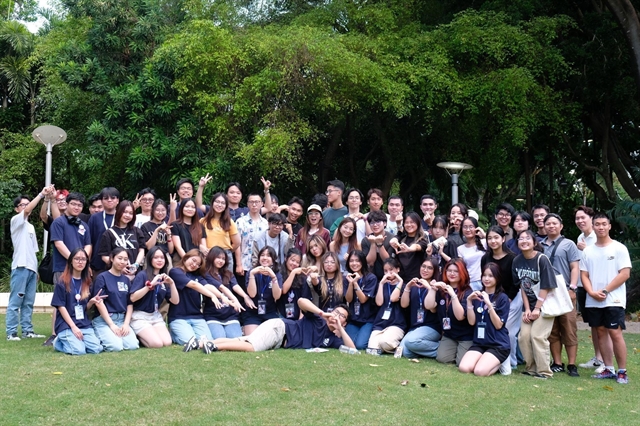 Society
Society
.jpg)
 |
| Deputy Prime Minister Trần Hồng Hà visits Quy Nhơn Fishing Port in Quy Nhơn Ward, Gia Lai Province on Thursday.— VNA/VNS Photo Sỹ Thắng |
GIA LAI — Deputy Prime Minister Trần Hồng Hà told local authorities to divide their preparedness and response efforts into three distinct phases to effectively cope with Typhoon Kalmaegi, which is forecast to bring extremely severe winds and heavy rainfall to the central and Central Highlands regions on Thursday.
Hà said the preventive phase must be completed no later than 1pm on Thursday, while the storm response phase will run from 6pm on Thursday to 8am on Friday.
The most critical period begins at 6pm on Thursday, when localities must ensure both residents and response teams strictly follow safety orders.
After the typhoon passes, each locality must move swiftly into the post-storm recovery phase, addressing damage and implementing appropriate follow-up measures.
Hà, who also serves as Standing Deputy Head of the National Civil Defence Steering Committee, issued the directive during an emergency meeting on Thursday at the forward command centre in Gia Lai Province.
The meeting connected officials from the localities of Khánh Hòa, Đắk Lắk, Gia Lai, Quảng Ngãi, Đà Nẵng and Huế, the areas expected to be most affected by the storm.
At the meeting, Hà praised provinces for pre-emptively releasing water from reservoirs before the typhoon’s arrival, while stressing that flood control must remain the top priority.
He urged local leaders to carefully determine the timing and volume of water discharges from reservoirs, balancing safety and flood prevention needs.
Calling the typhoon “highly complex and unusually large”, Hà said that the storm’s impact radius could extend up to 100km.
He told the National Centre for Hydrometeorological Forecasting to continue close monitoring and provide precise forecasts on landfall timing, rainfall, wind strength, tidal surges and specific areas at risk, information essential for timely decision-making by local authorities.
He also ordered provinces to strengthen and deploy rescue forces, vehicles and equipment in vulnerable areas, ensuring readiness for search and rescue operations, especially in zones likely to be cut off.
“The top priority is to safeguard human lives,” he said.
He also required authorities to ensure no one remains on vessels or in aquaculture farms when the storm hits.
Military and police units were told to maintain strict duty rosters, stand ready for emergency response, assist in evacuations, reinforce homes and protect barracks and warehouses.
Before chairing the meeting, the Deputy PM and Gia Lai provincial leaders inspected Quy Nhơn Fishing Port in Quy Nhơn Ward, where boats were taking shelter from the approaching typhoon.
Per official reports, as of Thursday morning, more than 61,400 vessels at sea had been contacted and guided to safety, with none remaining in danger zones.
Six provinces and cities from Đà Nẵng to Lâm Đồng have already issued sea bans, and evacuations in high-risk areas are being carried out urgently.
The evacuation plans for the provinces of Quảng Ngãi, Gia Lai and Khánh Hòa alone cover more than 126,000 households.
Essential supplies, including food, medicine and other necessities, have been stockpiled for evacuees.
Speaking at the meeting, Deputy Minister of Agriculture and Environment Nguyễn Hoàng Hiệp said that the typhoon is “one of the largest and most dangerous storms ever to hit the region.”
Gia Lai Province currently has 13 communes and wards within the high-risk zone, where sustained wind speeds are expected to reach levels 11–13, with gusts up to levels 15–16. Other areas will also face strong winds.
In Quảng Ngãi Province, seven communes and wards are at extreme risk, with winds expected to hit levels 10–12 and gusts up to levels 14–15.
Some coastal areas in Tuy Hòa are also in the danger zone.
Hiệp warned that at these speeds, winds could severely damage houses, blow off roofs and threaten residents’ safety.
He ordered that all residents in identified high-risk communes and wards must stay indoors, with an absolute ban on going outside from 6pm on Thursday.
Hiệp added that the typhoon is a multi-hazard event, combining strong winds, torrential rain and high tides.
The most dangerous period will be between 8pm on Thursday and 8am on Friday, with the storm’s centre expected to make landfall near the border between southern Quảng Ngãi Province and Gia Lai Province, around the area of Quy Nhơn.
Between 8pm on Thursday and 3am on Friday, there will be heavy rain and storm surges.
Coastal areas could face waves of 6-8m and sea levels rising by 1.5m, increasing the risk of flooding, Hiệp said, urging localities to reassess risk levels and adjust their storm response plans accordingly.
Representatives of the Ministry of Defence and Ministry of Public Security reaffirmed that during any storm or flood, local residents must play the primary role in self-protection, following the principle of 'five selves' to maintain self-reliance, self-strength, self-preparedness, self-sufficiency and self-safety.
Military and police forces will act as core support teams, assisting and protecting people.— VNS
.jpg)



